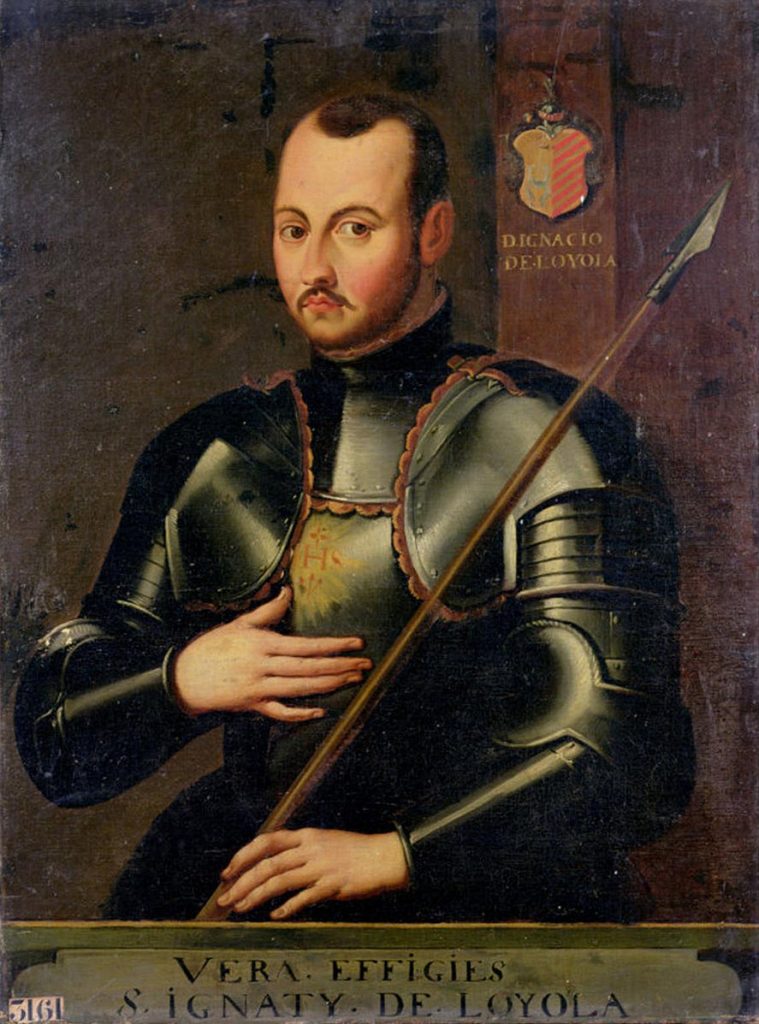St. Ignatius was a Spanish priest who founded the Society of Jesus, or Jesuit Order, in 1540. He intended the society to be servants of the pope, and therefore of the universal Catholic Church. The Jesuits have been given credit for responding to the Protestant Reformation and for winning back to the Catholic fold many of the people who had left the church.1 St. Ignatius, known as Inigo in Spanish, lived a life of chivalry in his early years. Before devoting his life to God, he was a dedicated solider, and it wasn’t until he came to a near death experience that he decided to change his life.
In 1521, Ignatius was a soldier fighting to defend the Spanish city of Pamplona alongside his master Antonio de Manrique, the Duke of Nájera, against the French. Negotiations began between the besieged Spanish and the French military leaders, and when talk of surrendering to the French came up, Ignatius was furious at the weakness of his Spanish negotiators. He wanted to defend the city or die trying.2 The French proceeded to attack the city. Unfortunately, Ignatius was shot by a cannon and was seriously injured. The cannonball had struck his legs and seriously damaged one of them. Fortunately, some French soldiers tended to his damaged leg. The soldiers saved his leg from amputation, so in return, Ignatius gave away his shield, corset, and dagger to the French soldiers. From the battlefield, Ignatius was transported to northern Spanish town of Anzuola to recover.

When Ignatius arrived in Anzuola, the doctors decided that it would take multiple surgeries to help him. First, they decided that his leg had to be broken again and his bones reset. During the first operation, Ignatius did not utter a single sound, and the only indication of pain he gave was clinched fist. The operation brought Ignatius to near death. He was advised to confess his sins to a priest, and was told that if he did not feel better, he could consider himself a dead man. That night Ignatius prayed to St. Peter and later that night he started to feel better. However, something went wrong during the second surgery. As the bones in his right leg settled, a piece of the bone had started to push itself forward from his knee creating a stub.3 Ignatius immediately demanded another operation be performed. Ignatius believed that life had no purpose if he could not prove his courage to women or wear the elegant knee-boots of the hidalgo.4 The doctors advised against this, but Ignatius insisted. Again, he did not utter a single sound during the very painful surgery. The surgery was a success, but Ignatius remained bedridden for months. When he was well enough to read, he requested books of chivalry, but there were no books of that kind in the castle. Instead, he was given The Life of Christ and The Lives of the Saints.
These two books had a great impact on his life. At first, Ignatius read these books in disgust. He dismissed the saints for the penances they performed. Slowly, the nobility of their actions grew on him. He was able to find things that he admired about them. One saint that caught Ignatius’s eye was Saint Francis. He admired St. Francis’ courage, his love of dancing, his singing, and his love for nature. These books changed the way he thought about life. He wanted to be a working servant of Christ, like St. Francis had been. While he was recovering, he saw a vision of Mary, the mother of God, and was filled with joy. This vision of Mary made Ignatius completely devote his life to God.
After he had recovered, he gave all his clothes away and became a hermit and focused on helping the sick. He wrote about his experiences, which eventually became known as the Spiritual Exercises. He knew he would need an education to help convert people, so he went to Barcelona to further his education. He became a priest in 1537. In his earlier life he had been a faithful and dedicated solider, and now he brought those same characteristics to his life in the priesthood. In 1540, Pope Paul III confirmed the formation of the Society of Jesus. Ignatius led the Jesuits along the lines of his military experience, but instead of fighting on military battlefields, they were to dedicate their military-like focus to serving the interests of God and to converting people back to the Roman church. When Ignatius died in 1556, there were one-thousand Jesuits working in Europe, Asia, and the Americas.5 The Jesuits have been known ever since for their strong belief in education and for their missionary work. Today, Jesuits can be found throughout the world, contributing to their missionary work and to their many schools.
- Salem Press Biographical Encyclopedia, 2005, s.v. “Saint Ignatius of Loyola,” by Carol S. Berg. ↵
- Hugo Rahner, St. Ignatius of Loyola: a pictorial biography (Chicago: H. Regency, 1995), 14. ↵
- Hugo Rahner, St. Ignatius of Loyola: a pictorial biography (Chicago: H. Regency, 1995), 14. ↵
- Philip Caraman, Ignatius Loyola: a biography of the founder of the Jesuits (San Francisco, California: Harper & Row, 1990), 26. ↵
- Salem Press Encyclopedia, 2015, s.v. “Society of Jesus (religious order),” by Rebecca Kraft Rector. ↵


46 comments
Christopher Metta Bexar
i found the article worthwhile because like many I find the lives of the saints interesting. Loyola sounds a bit like a character I saw in a biopic of St. Francis ( the man who loved Francis’ dear friend who became a nun and resented Francis for her doing that).
The story of his healing is also instructive. It gives an outsider a view of how he changed as a person to become the man who was canonized.
Dalton Moy
I always enjoy reading about the lives of the saints. There is always usually a connection I can make that I did not have knowledge of prior. I have known about Ignatius’ order, the Jesuits, but I hadn’t ever read about their work of converting people back to Catholicism after the Reformation. That was interesting to learn. I also did not know of Ignatius’ admiration of St. Francis. That was very cool to find out, because Francis is my Confirmation saint. Ignatius lived a very interesting life, and his deciding to change his life greatly helped the church as a whole.
Eric Ortega Rodriguez
I know of numerous Saints but never had taken the time to look into their life stories. After reading this article, I admire St. Ignatius Of Loyola because he persevered through so much in order to defend Pamplona. It is obvious that through him it can be seen that God has his plan for everyone and that only He knows what he has down the road for us. After being such a tough soldier, he devoted his life to God. St. Ignatius demonstrates the true meaning of mind over matter when it came to his surgeries. He is truly an outstanding man and role model.
Danielle Slaughter
What a life! I actually teared up a little when the French soldiers saved him on the battlefield, even as he was charging against them. Perhaps it was his stubbornness that kept him from crying out during his operations, some sort of inner pride he had to hold on to, but I can’t believe he underwent such a drastic change of heart. It’s quite funny that a man we revere as a saint today used to find them so annoying! I think it goes to show that while no one is perfect, we can always devote ourselves to what is good and pleasing to God if we so choose.
Belene Cuellar
Ignatius was a man that believed solely on his strength and his ability to cause pain as a fighter. He never once considered a different lifestyle until his near death experience. Even then it took patience and acceptance for him to finally think about becoming someone that didn’t battle or inflict pain. His near death was a major life change for him that brought Ignatius closer to god.
Luisa Ortiz
Reading the life of saints is really interesting, many we think that in order to be a saint you have to be a super “HOLY” well educated, good, good person, and in reality, most of the saints had a “turn out” in their life’s. Like Saint. Ignatius of Loyola. The article is well writing and fascinated facts, like how he did no glitch in his surgeries or how he started his conversion by reading about other saints.
Luke Lopez
This was a very interesting article that provided information on St. Ignatius of Loyola’s life. St. Ignatius was an ardent defender of his country, and later on became an ardent defender of the Catholic faith when he became a priest. It is also very interesting that St. Ignatius became a hermit, and wrote about his experiences in the “Spiritual Exercises”.
Eric Ortega Rodriguez
Growing up, I knew about lots of Saints but never had taken the time to look into their stories. After reading this article, I find it amazing how St. Ignatius Of Loyola went through so much to defend Pamplona. It is also amazing to see that God has his plan for everyone. After being such a tough soldier, he devoted his life to God which is very admirable. St. Ignatius also demonstrates the true meaning of mind over matter when it came to his surgeries. He would not say a word and endure the pain with only clenching his fist. Truly, an outstanding man and role model!
Matthew Bustamante
An excellent article. What is astounding to me is the way that men of all kinds have the opportunity to become saints. The life of St. Ignatius is another example of men and woman who accept the call of God to perfect His creation and spread the Truth within the Catholic Church. What captivated me most about this article was the section of how Ignatius was reluctant to letting his leg inhibit his status with the fleshly passions. He threw his wealth and pride aside and made a true conversion. This is a motivation to me being a Catholic from birth and having the Jesuit moto tattooed on me “For the greater glory of God”. The Jesuits continue to contribute greatly to the sciences and humanity. Great article.
Pedro Gonzalez Aboyte
Coming from a Jesuit high school, I know all about St. Ignatius. It is a fascinating story about a man who turned his entire life around. He was someone who didn’t care for much except himself and liked to party and be with women. All of this changed once a cannonball gave him a serious injury. The books he asked for were the reason for his transformation as well as him going to Manresa where he reflected upon his life. St. Ignatius was in the center of my education during high school and we strived to be like was in the latter part of his life.